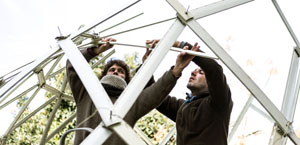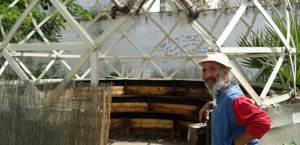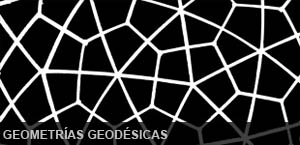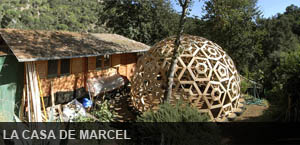>>>>>>>
the Tree – Self-sufficient system
ATTENTION: THIS PROJECT IS THE RESULT OF A COLLABORATIVE PROCESS BETWEEN CTRL+Z AND LUCIANO FURCAS, WITH THE COLLABORATION OF IRINI SFYRY. IT WAS BUILT WITH THE PARTICIPATION OF MANY VOLUNTEERS. WE ARE THANKFUL TO THE REY MORO GARDENS FOR THE OPPORTUNITY AND THE RECEIVED SUPPORT AND TO JAVIER NAVARRO FOR THE PHOTOGRAPHIC FOLLOWING OF THE ASSEMBLY.
Background
In Ctrl+Z we are always interested in implementing work schemes that establish synergies between the already active local initiatives necessities and the one we have to advance in our researches being able to test their insights and results realizing real scale projects. To achieve this we tend to incorporate and base on the urban cycles discarded materials, as part of the proposed activities environmental and social sustainability.
The idea of reusing blinds slats to build a geodesic greenhouse dates back to 2012 during the investigations that led to the design of “La Casa de Marcello“.
 Sevilla’s San Julian neighborhood luckly witness and enjoy Luciano Furcas`s permaculture work. Along with many volunteers Luciano develops green initiatives in areas such as the “Colegio de Santa Marina” or “Huerta del Rey Moro”, a neighborhood urban garden a few meters away from our studio.
Sevilla’s San Julian neighborhood luckly witness and enjoy Luciano Furcas`s permaculture work. Along with many volunteers Luciano develops green initiatives in areas such as the “Colegio de Santa Marina” or “Huerta del Rey Moro”, a neighborhood urban garden a few meters away from our studio.
Over the past two years we had spoken on several occasions about the opportunity of building a permanent geodesic structure in the garden for the development of activities, an approach that for its relevance is being discussed within the assembly that manages it.
In the fall of 2014 rises the possibility to implement an ephemeral structure as seedbed, idea that gradually took shape in a blinds geodesic greenhouse to support the development of the scholar garden program.
Being a light and temporary intervention, the building could be managed with Luciano in an agile and almost immediate way.
 Greenhouse and blinds
Greenhouse and blinds
We begin to become familiar with the different types present in the “market” of the blinds abandoned in the streets of Seville. After few days we had found a good number of them, enough to complete half of the structure.
Although these early findings could not finish the structure, its presence in the garden facilitated the work of searching for missing ones.
Actually we thought, perhaps naively, to solve the problem contacting the “clean points” of Lipasam (Seville’s municipal Public Cleaning enterprise), but they told us that once entered into their facilities materials could not be yield.
Similarly we contacted shutters installation companies, that generally informed us that the law imposes them to bring to the clean points the blinds retired when they install the new ones.
Anyway thanks to the creation of an effective network of Rey Moro’s or “Ctrl+Z’s friends which tracked the streets in their daily routes as “informers” warning us of blinds presence, we could collect the wide slat blinds we needed to terminal the structure in just one week.
Zome
We realized the first working day on January the 10th with the presence of Catarina, Luciano and Arturo and we followed with a second the next Saturday in which the structure was completed with the help of more friends like Nacho, Jaunito and Ciro.
Finally we did not realize a geodesic structure but a “Zome”, term coined by Steve Durkee in 1968 by merging the words “zonohedron” and “dome”. The zomes are not based on a spherical or elliptical system, but are compounds geometric volumes of facets arranged in a double spiral.
Despite that, from the technological point of view we consider this project as a natural evolution and continuation of the first experiments on the system of “axial knot / curve rod” for the realization of geodesic structures, explored with the iron structure of the Temazcal Mexico in 2010 and evolved with the bamboo one built in Brazil in 2013.
The zome’s assemblage was quick and uneventful allowing us to ensure and  demonstrate that the patterns we created for the construction of geodesic domes are feasible and applicable directly and immediately to different geometric configurations.
demonstrate that the patterns we created for the construction of geodesic domes are feasible and applicable directly and immediately to different geometric configurations.
Besides the success of this construction demonstrates once again that a reused material, even if not in perfect condition, may be perfectly adequate for a new function, after it has complied with the previous and before ending up in the garbage (hope really for recycling).
It also demonstrates that those structures are not as complex, and that if they are investigated for low-tech focused on selfconstruction solutions, not specific and highly technological materials are needed for their implementation.
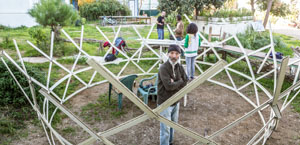


Use and concept evolution
With the perspective of time the responsible for the scholar activities of the garden expressed doubts about the opportunity to fill their assigned area with an enclosed space.
At the same time the shading reed structure already present in the orchard was showing collapse signs so before the process went too far it was decided to disassemble it and reuse its materials. The reeds were used for the realization of the scholar gardens terraces while the stones and wood were reused for the base of the new structure.
Following these events the idea of providing the urban garden of a seedbed and a greenhouse, was transformed. Luciano designed a closed water cycle based on the structure and on a different plant species set to configure a sustainable and synergistic system which will also include a water harvesting tower and composting..
The base
The base was built during February starting from the materials already present in the garden and in April the inner surface was equipped with vertical planters to plant vines that will cover the zome providing shade. Those were prepared reconfiguring mining prospecting boxes.
in April the inner surface was equipped with vertical planters to plant vines that will cover the zome providing shade. Those were prepared reconfiguring mining prospecting boxes.
The oil needed for their protection has been provided by the kitchen of a local restaurant that Luciano managed to filter, perfume and prepare to make it suitable as wood protector.
The outside was covered with reed rolls also recovered in the street, these contribute to the aesthetics of the whole and offers climbing plants the necessary grip.
Once again we could count on a varied and powerful group of volunteers including JuanRa, Sara, Marta, Miguel, Catarina, Irini, Berta, Joso and Marco.



Next targets
The research activity developed with Luciano and Irini will now allow us to start implementing the “fogcatcher”, the “engine” that will provide the system with self-sufficiency.
Our proximity to the garden has allowed and will allow us in future, to perform a constant and careful monitoring of the project evolution, adapting to new requirements and responding to the different situations that arose during the process.
We’ll continue to work with Luciano and the Rey Moro’s team to consolidate this initiative and transform it into an useful equipment for this wonderful “urban oasis”.
We report a text developed in collaboration with Eirini Sfyri Triantafyllos and based on her conversations with Luciano Furcas:
Design concepts
Water is a limited resource and urban gardens finding themselves compressed into the dense structure of cities often suffer lack of land. So both for planting as to harvest the water gardening requires, is convenient to consider also the vertical dimension.
 To plant you can create a structural basis for the plants so they can stack up and develop into the air, occupying less land. To get water we can inspire in the structure of the trees that as organisms don’t require special care and occupy less horizontal and more vertical space.
To plant you can create a structural basis for the plants so they can stack up and develop into the air, occupying less land. To get water we can inspire in the structure of the trees that as organisms don’t require special care and occupy less horizontal and more vertical space.
From these two concepts, the dome is designed as a “system” with the intention of adding mechanisms that reproduce functions similar to the trees ones and create this way a system of self-sufficiency in the Rey Moro’s garden.
The tree system
Trees system is a natural and self-sustaining system that with its mechanisms take part in the overall water cycle and at the same time creates its own local one.
Participates to the first absorbing rainwater and transforming it into vapor through transpiration from the leaves (1).
The second begins with the morning dew. As the sun rises it heats the ground and the exposed parts of the tree, leaving the lower part colder. Once the steam get in contact with the colder parts of leaves, it condenses into water drops that through the trunk slide down to the ground and thus fed back the roots (2).
Furthermore leaves, that at the end of their life cycle fall to the ground, decompose fueling the soil and roots (3).
THE DOME
 The structure
The structure
The dome was built of reused and recovered materials as dictated by the philosophy of garden. The base consisting of pallets and stones (recovered from the previous reed structure) was coated with an university prototype panels and the dome was assembled from used plastic blinds (recovered on the street).
In the base’s interior surface a structure of wooden boxes, that were reconfigured and treated so that they could serve as planters, was settled.
The plants
To try to recreate an autonomous and self-sufficient system similar to the trees one, the interior and exterior of the dome will be covered by “perennials plants”.
The perennials are rapid growth herbaceous plants. During winter stems and leaves dry, but its roots still stay alive underground, returning to sprout in spring.
We’ll begin planting nasturtiums, and we’ll follow the study of local species to choose the more appropriates.
Next to them is committed the emergence of “spontaneous or opportunists plants” that taking advantage of the moisture of the dome system, will incorporate into it. Spontaneous plants are plants that arise without help, without the will or the direct mediation of the human being and thus they grow independently.
Often spontaneous plants are considered “bad” plants, however they bring beneficial effects, such as attracting pollinating insects, conserve biodiversity, restore disturbed ecosystems, stop erosion, store toxic, or even they can be edible and medicinal plants. In the case of our system, they will also maintain system operation during the autumn and winter months when perennials dry.
Vines will cover the entire top portion of the dome. Thus the sun as in a tree, will heat the exposed portion and the interior of the dome will keep a lower temperature.
The fogcatcher
Finally, to make our system self-sufficient , it need to be able to harvest independently the water it needs for its operation. To achieve this, inside the dome, a fogcatcher structure will be implemented. A Raschel mesh, able to capture the morning dew, humidity and steam produced by plant transpiration and transforming them into water drops through condensation, will be installed.
Droplets, once formed, will begin to fall and accumulate in a fountain in the center of the dome. In the bottom part of the fogcatcher other type of mesh, capable to collect both dew and rain water, will be used. The fountain will be always filled with water and through a distribution system based on geotextile, all plants participating in the system will be irrigated.
Like all systems this one will produce some surplus as the moisture that does not become water that will feed spontaneous plants, dry leaves that will fall on the ground creating a layer of mulch that keeps soil moisture and protect it, or the water that will overflow from the fountain, which will be transported and stored into another location outside the system and will serve the rest of the garden irrigation.
The human being
Create a mechanism of self-sufficiency is a slow process, but it is a system that works by itself without the need for “engines”. We will do what is necessary to “raise” and “activate” whole body to let it then work alone. All its systems will develop functions similar to those of the organs in the human body. We’ll have moisture that with temperature difference will condensate and the produced water will feed the “digestion”.
Although it will be a self-sufficient system, the human being will also be part of it naturally. Entering and moving within the dome helps air circulation and activates the system with his energy.
 2018, CLOSING A CYCLE
2018, CLOSING A CYCLE
During it’s years of life numerous climbing plants such as bougainvillea, jasmine and wisteria rose climbed up the structure combining with palm leaves from the same orchard, thus favoring the maintenance of moisture and freshness, a very important aspect in Seville.
At the end of spring 2018 the structure had been damaged by unknown people. Requested by the users of the orchard who appreciated its presence as a positive element, maintenance days where organized together to completely replace the lower rings of the orchard and reinforce the upper ones.
In September of the same year, a new destructive action took place. The newly replaced base rings were irreparably damaged and, without them, the structure had tilted dangerously on one side. It was therefore decided to clear the structure, which resulted in a no easy task.
It was therefore decided to clear the structure, which resulted in a no easy task.
In spite of the situation in which it found itself, the remaining portion of the structure ,offered a lot of resistance and it was not possible to destroy it, not even by hanging on to it. Probably that resistances has been the factor that made those who tried to end with it, decide to give up.
It was necessary to dismantle the structure bar to bar and screw to screw ,demonstrating, once again, the robustness of a structure based on used blinds that assumed, for four years, a structural function for which they were never thought.
The screws have been kept to give them new uses in the orchard, and even if, in the community of the orchard, the right conditions will appear in the future, to rebuild a new structure, more solid and beautiful if possible…
One of the main lessons we can learn from this experience is however the consequence of the observation of its evolution that  has developed in parallel with the evolution of the community that moves around it. It is no coincidence that its construction and growth coincided with the presence of a community in harmony, while the damage appeared in parallel with the conflicts.
has developed in parallel with the evolution of the community that moves around it. It is no coincidence that its construction and growth coincided with the presence of a community in harmony, while the damage appeared in parallel with the conflicts.
This only reinforces, once again, the idea that for the creation of resilient projects it is not only necessary to look at the materials, but also, and above all, at the relationships that these projects can establish with the communities that appropriate them.














